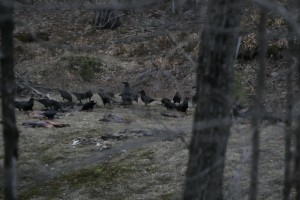Spring-like weather lures flowers to fateful early bloom
Our fine hot spring-like weather may have taken a slight turn to where it should be at this time of year.
A little snow might fall. If it does get as cold as what is predicted some of the flowers that popped out during that nice warm weather may take it in the shorts.
The catkins are all out on the Speckled Alder. The pollen will fly if you touch them. My Daphne bushes are in bloom a month earlier than normal.
The bushes spruced up the driveway for a week or so but I don’t think there will be any red berries on them this year.
This plant has its origins in Russia where it is the first bush to bloom in season.
Many people who go south miss the entire beauty of this bush growing in their yards.Bill Marleau was the one who turned me on to it years ago. It grew wild in the ditch down by the Rondaxe Road corner.
I moved a few little bushes and berries and now I have hundreds along the driveway. They are somewhat Deer resistant.
Here at Eight Acre Wood I have hundreds of little Balsam trees growing in heights from one to five feet tall.
Anyone who wants a few for their yard can bring a shovel and take them away.
They all seeded from one lone tree down by the pond. They are easy to move as they are shallow rooted and take well in almost any location.
The Deer do nibble on these but if you protect them until they get five feet tall they will make a nice tree for your yard.
A Hummer was reported in Indian Lake on Saturday. That wouldn’t surprise me at all with all this warmer than normal weather.
However, it may have to stick its beak into a frozen feeder tomorrow morning (3/27).
I have a correction to last week’s column. The new record New York State Big Buck Record bow kill buck scored 210 4/16. It was correct under the picture but not in the text.
I went from trapping beavers to banding birds and have caught a few in the last couple of days.
I also got two nice returns, a Black-capped Chickadee and a female Downy Woodpecker.
Both were banded in January of 2009, but I hadn’t seen the Woodpecker since then.
During the Project Feeder Watch count that I do each weekend I had never gotten more than four Downy Woodpeckers at one time.
I put the nets up and caught nine new unbanded woodpeckers and the one banded bird so there were at least ten using my feeders— maybe more.
The Red-bellied Woodpecker bounced off one net and got away but he will be back. He hollers at me every time I go out in the yard and gets especially mad when I’m taking one of the screaming Downys out of the net.
A lot of people think of Ravens as scavengers not predators, but I think they are both.
They do patrol the highways and pick up road kill, but I believe they raid other birds’ nests for eggs and young birds.
With all the carcasses I put on the dam of the pond I had a big influx of Ravens over the weekend.
Once a dead critter is discovered by one of them they call in the troops.
I had 31 Ravens, which was the most I counted as they flew in and out.
This also attracted four Turkey Vultures that saw all the activity and knew there must be something good to eat here.
There was also one immature Bald Eagle. None of the other birds got in the way when he arrived to eat.
The Red-tailed hawk had a little more difficulty getting a space at the table but managed to get some food before moving on.
I have to assume that the Ravens aren’t on nests yet but they will be shortly as their kids are normally out of them by Memorial Day.
Biodiversity Research Institute, which runs our Common Loon Program, also does research on other top predators and checks them for mercury pollution.
One such species is the Peregrine Falcon and there is now a web cam on a nest in Maine where the first egg was laid March 16th.
The egg will take 34 days to hatch so you can watch the progress at: http://www.briloon.org/oae/webcams/peregrinecam.
There are only 24 known nesting pairs of Peregrine Falcons in Maine where they are still on the endangered list.
A few more birds need bands, but that’s another story.
See ya.

